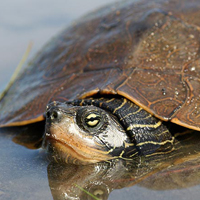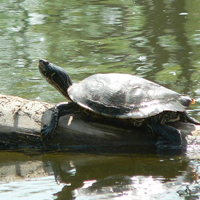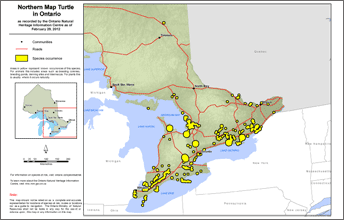Northern map turtle
Scientific name: Graptemys geographica


Cover photos credit: Scott Gillingwater (left) and Alan Dextrase (right)
Status
Special Concern
“Special Concern” means the species lives in the wild in Ontario, is not endangered or threatened, but may become threatened or endangered due to a combination of biological characteristics and identified threats.
Date added to the Species at Risk in Ontario List
The Northern Map Turtle was already assessed as a species of special concern when the Endangered Species Act took effect in 2008 and was re-assessed as special concern in 2013.
Read the report (PDF)
What it looks like
The Northern Map Turtle gets its name from the lines on the upper shell, or carapace, that resemble contour lines on a map. The lines on the carapace are shades of yellow, tan, or orange and are surrounded by dark borders. The rest of the carapace is olive green or greyish brown. The lower shell, or plastron, is light yellow to cream. There is a yellow spot behind the eyes, and both the head and legs have an intricate pattern of bright yellow lines.
Females can grow to about twice the size of males in length – and may exceed 25 centimetres versus an average of only 14 centimetres for males. Another difference between males and females is choice of their diet. Females eat molluscs, including clams and snails, as well as crayfish and some fish. The male and young map turtles mainly eat insects and crayfish.
Female Northern Map Turtles may take more than 10 years to reach maturity. They nest from June through July and lay a single clutch of 10 to 17 eggs per year. The eggs hatch in the fall. In some cases, the hatchlings overwinter in the nest.
Where it lives
The Northern Map Turtle inhabits rivers and lakeshores where it basks on emergent rocks and fallen trees throughout the spring and summer. In winter, the turtles hibernate on the bottom of deep, slow-moving sections of river. They require high-quality water that supports the female’s mollusc prey. Their habitat must contain suitable basking sites, such as rocks and deadheads, with an unobstructed view from which a turtle can drop immediately into the water if startled.
Where it’s been found in Ontario
The Northern Map Turtle’s range extends from the Great Lakes region west to Oklahoma and Kansas, south to Louisiana and east to the Adirondack and Appalachian mountain barrier. There are isolated populations in New Jersey and New York states. In Canada, it is found in southwestern Quebec and southern Ontario. In southern Ontario, it lives primarily on the shores of Georgian Bay, Lake St. Clair, Lake Erie and Lake Ontario, and along larger rivers including the Thames, Grand and Ottawa.
View a larger version of this map (PDF)
What threatens it
Habitat loss and degradation due to shoreline development and decline in water quality threaten the Northern Map Turtle in Ontario. The spread of invasive species such as Zebra Mussels also poses a potential threat to this species. It is also vulnerable to mortality on roadways and injury from boat propellers.
The pet trade may be contributing to declines of this species in the United States and Canada. The Northern Map Turtle resembles several popular pet trade species, and illegal capture and export may be taking place.
Action we are taking
Special concern species do not receive species or habitat protection.
What you can do
Report a sighting
- The Ministry of Natural Resources tracks species at risk. You can use a handy online form to report your sightings to the Natural Heritage Information Centre. Photographs with specific locations or mapping coordinates are always helpful.
- Visit the Ontario Nature Ontario Reptile and Amphibian Atlas or Toronto Zoo Adopt-a-Pond website to learn more about Ontario’s rare turtles, their habitat and related conservation initiatives.
Volunteer
- Volunteer with your local nature club or provincial park to participate in surveys or stewardship work focused on species at risk.
Be a good steward
- Private land owners have a very important role to play in species recovery. You may be eligible for stewardship programs that support the protection and recovery of species at risk and their habitats.
Report illegal activity
- Report any illegal activity related to plants and wildlife to
1-877-TIP-SMNR (847-7667) .
Quick facts
- The female Northern Map Turtle has powerful jaws for crushing the shells of molluscs, its primary food source.
- The Northern Map Turtle is extremely wary and will dive into the water at the slightest provocation.
- Northern Map Turtles are known for their communal basking, and may be found piled up together in several layers of up to 30 turtles.
- Map turtles will often bask at the surface of the water under floating vegetation mats with nothing but their head or nose visible from the surface. This behaviour puts map turtles at significant risk of mortality from motorboats.
